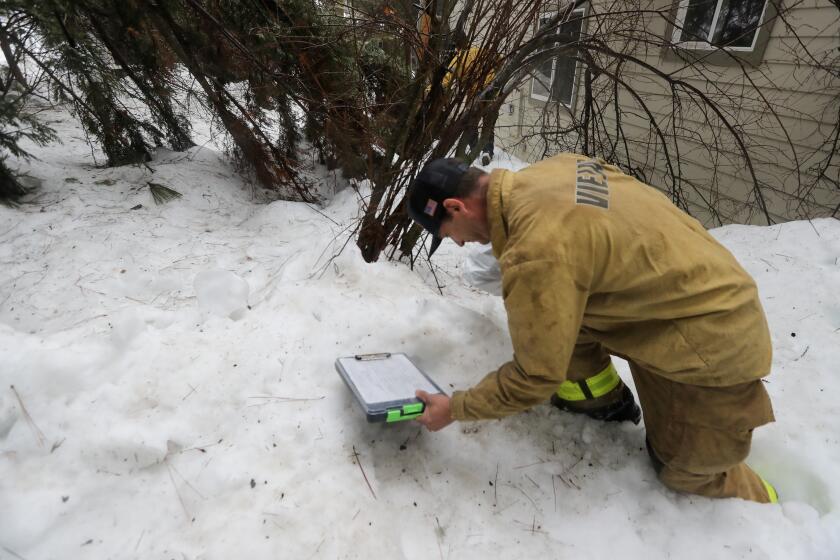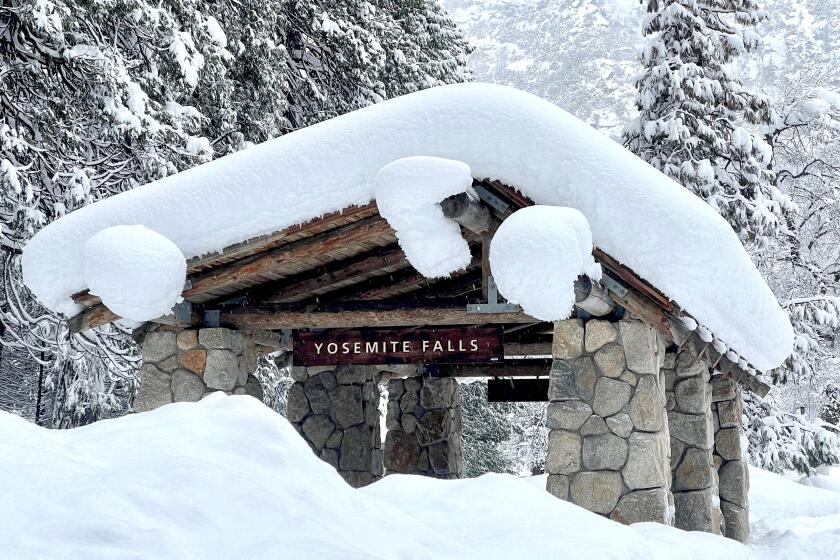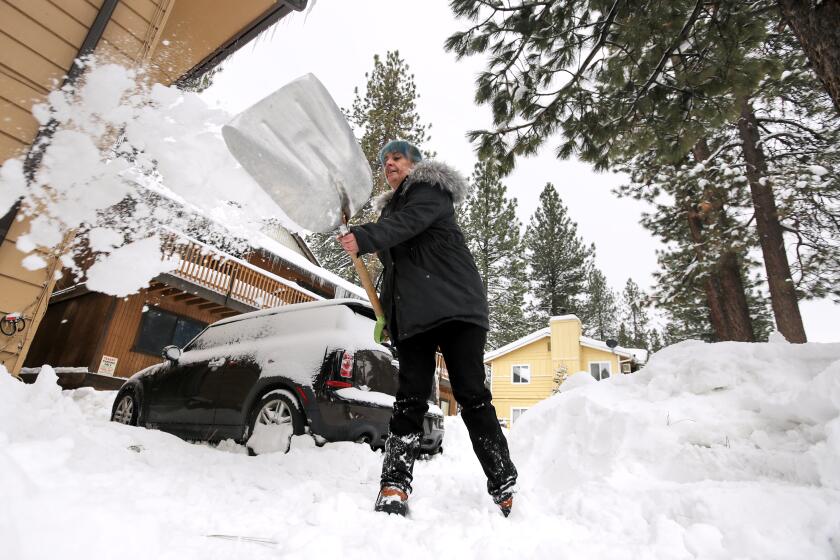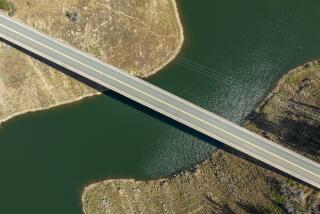Winter storms ease drought conditions in California, report shows
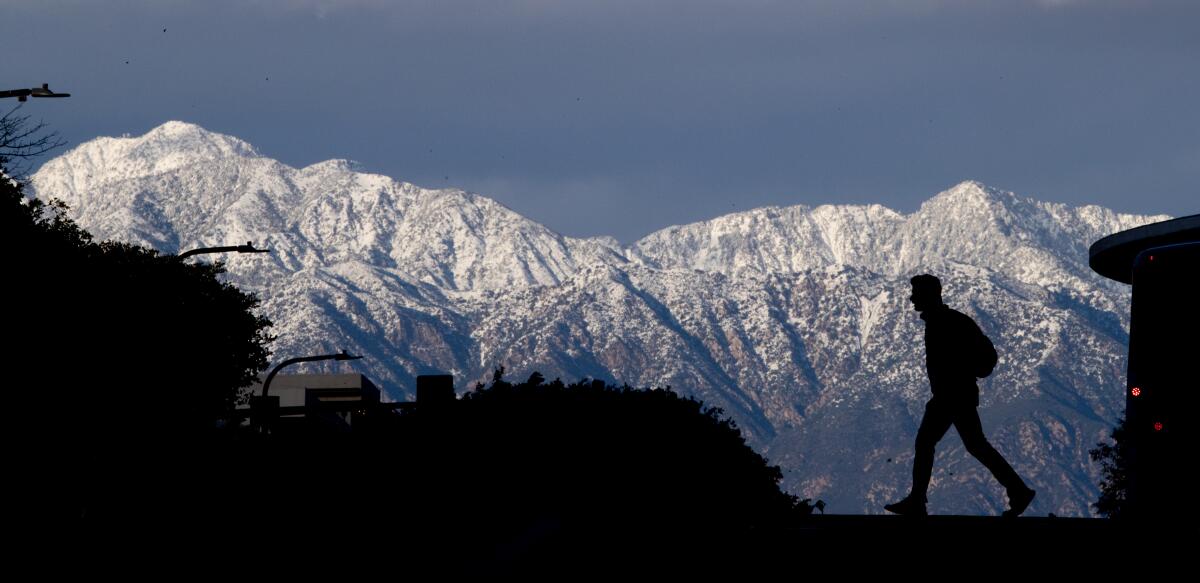
- Share via
California’s remarkably wet winter has helped ease drought conditions considerably, with large swaths of the state — including the coast of Humboldt County, much of the snow-capped Sierra Nevada and the Santa Monica Mountains north of Malibu — no longer considered to be in drought, according to federal officials.
The latest estimate from the U.S. Drought Monitor, released Thursday, shows almost 17% of the Golden State has exited drought completely, with an additional 34% now classified as “abnormally dry.” That means less than half of the state remains under drought conditions, which range from moderate to exceptional drought, according to the monitor.
“It’s pretty amazing, the changes, not only over the past week but going back to December of 2022,” said Brad Pugh, a meteorologist with the National Oceanic and Atmospheric Administration and one of the authors of the Drought Monitor. At the end of last year, no part of the state was classified as out of drought and less than 1% was considered abnormally dry.
Officials attributed the development to the recent winter storms that dropped heaps of rain and snow in several regions, including Southern California and the Sierra, as well as the series of nine atmospheric river storms that hammered California in January.
“The Pacific weather systems of this week and last week added to copious precipitation that has been received from atmospheric rivers since December 2022, especially over California and states to the east,” the latest update said.
According to their mapping, which includes data on hydrology, soil moisture and other climate indexes, “Central California’s Sierra Nevada mountains and foothills are now free of drought and abnormal dryness for the first time since January 2020.”
California’s deadly storm season continued Friday as the first of two atmospheric river storms descended on the state, prompting evacuation orders.
The rain and snow arrived on the heels of California’s driest three years on record, which contributed to dramatically low reservoir levels, urgent conservation orders and a statewide drought emergency declaration. That declaration, issued by Gov. Gavin Newsom in October 2021, remained in place as of Thursday.
Jay Lund, co-director of the Center for Watershed Sciences at UC Davis, said it would still be premature to rescind that order — at least until April 1, which typically marks the end of the state’s wet season and the point at which full assessments can be made.
“It’s a hard decision for the governor because California is a really big place, and it’s very diverse, so even in some wet years there can be parts of California in drought, and in some dry years there can be parts of California that aren’t in drought,” he said.
For example, portions of the San Joaquin Valley and Southern California have already experienced a wetter-than-average season, but other areas, including the Sacramento Valley, are still below average, Lund said. “Since you don’t really know what this year’s going to be until the end of March, and you don’t want to make declarations and then rescind them, it’s probably best to wait until the end of March.”
‘This is the most any of us have ever seen,’ one ranger at Yosemite said. There is no date for reopening as officials respond to snowfall of up to 15 feet deep in some areas.
But there is no denying the moisture made a difference. Statewide snowpack is 192% of normal, according to state data. In the southern Sierra, it’s 232% of normal. Snowpack typically provides about one-third of California’s water supply.
Snowpack was so substantial that the Yosemite Valley broke a 54-year-old daily record on Tuesday, when 40 inches of fresh powder fell, surpassing the 36-inch record set in February 1960. As much as 15 feet fell in some parts of the park over the course of the storm.
Reservoirs have also seen a boost this winter, with Lake Shasta and Lake Oroville now at 60% and 73% of capacity, respectively, up from 34% and 37% two months ago. More rain and snow are expected next week and possibly throughout all of March.
“The pattern through the next two to three weeks appears colder than normal, so we should be able to maintain the snowpack, and signs are good for even enhancing the snowpack over the next couple of weeks,” Pugh said.
Still, the Drought Monitor estimates that roughly one-quarter of California remains in the third-worst category: severe drought. Those areas include portions of eastern San Bernardino and Inyo counties, as well as multiple counties in the northern part of the state. About 24% of the state is under moderate drought.
Lund said the map can be a helpful “rough indicator” of hydrologic conditions, but it’s not always a reflection of available supplies. People who are dependent on groundwater, or people who are concerned with forests and endangered species, “probably are still very worried about drought and the lingering effects of drought,” he said.
Crews race to clear mountain highways after calling off plans to escort residents out because even cars with chains on their tires were getting stuck in snow.
Indeed, though the update reflects measurable drought relief, the report’s authors note that three years of dryness have further depleted some historically low groundwater levels, and that some aquifers may take “months to recover.”
Southern California’s other major water source, the Colorado River, also remains perilously low as the American Southwest suffers one of its driest two-decade periods in more than 1,200 years.
“What we have here in California is two things on top of each other: a chronic overuse of water, relative to average water availability in many parts of the state, and we have natural climate-enhanced fluctuations in water availability both on the wet sides and the dry sides,” Lund said. “We need to be banking more of that ‘wet year water,’ and we need to get used to using less water, even in wet years.”
Department of Water Resources director Karla Nemeth said officials in the coming weeks will be “assessing the impact the latest round of storms has had on the drought.”
“It’s great to see improved conditions reflected in the U.S. Drought Monitor,” Nemeth said in a statement. “We continue to monitor conditions across California, and while recent rain and snow has been promising, it will take more than a single wet year for California to fully recover from the last three years — the driest ever recorded in state history.”
However, California’s water managers have received some criticism for their response to this winter’s wild weather, which has required both flood control and stormwater capture efforts, often simultaneously. As trillions of gallons were channeled out to the ocean during the recent storms, many residents and elected officials called upon state and local agencies to do more to improve their response.
State water officials are expected to gather Friday for their third snow survey of the season.
More to Read
Sign up for Essential California
The most important California stories and recommendations in your inbox every morning.
You may occasionally receive promotional content from the Los Angeles Times.
